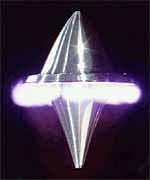Lightcraft research and propulsion concepts
Myrabo is recognized as the inventor of lightcraft. [4] [2] [5] In 1983, a NASA-sponsored study authored by Myrabo at the BDM Corporation outlined his earliest propulsion concept, which proposed using beams to ionize air in front of a vehicle to generate thrust. [6] Wired reported that he first developed the ideas that became the technology in 1988. [7] At the time, he was working on the "Star Wars" missile defense initiative under the Ballistic Missile Defense Organization. [7] Lightcraft use a type of beam-powered propulsion. [8]
Through the late 1980s and 1990s, Myrabo refined these ideas, adapting them to the limitations of then-available laser systems and promoting variations such as beamed microwave propulsion. [6] He researched the project through the first successful launch in 1997, and participated in more than 140 test flights with various prototypes. [7]
During this period, Myrabo began experimental work at the High Energy Laser System Test Facility at White Sands Missile Range, where, in collaboration with the U.S. Air Force, he conducted the first sustained outdoor Lightcraft flights. [4] Between 1996 and 2000, prototypes powered by pulsed carbon dioxide lasers reached altitudes of up to 233 feet, milestones he compared to the modest early rockets of Robert H. Goddard. [4] [3]
Over time, he and his partners carried out more than 140 small-scale test flights, supported by funding from NASA, the Air Force, and the Strategic Defense Initiative. [7] Tests at White Sands used a 20-hertz, 9-kilowatt carbon dioxide laser, with flights reaching altitudes of 75 feet in three seconds. [2] Myrabo was later involved in further laser propulsion research at Marshall Space Flight Center. [9]
Advocacy and predictions
Myrabo coupled this experimental program with a broader advocacy campaign. [10] He discussed variants of the lightcraft concept with Popular Mechanics in 1995, including the notion of using pulsed microwave beams from satellites to reduce drag on and propel lightcraft. [6] In 1999, he published an article in Scientific American describing his vision of ground-based "LightPorts" and orbital power stations that could beam energy to passenger-carrying spacecraft. [10]
He reiterated these claims at conferences in the 2000s, forecasting satellite launches at a thousand-fold cost reduction and predicting that by 2020 laser-powered craft could fly passengers globally in under an hour. [7] [10] While his optimism drew skepticism from other aerospace engineers, he remained confident that falling laser costs and rising fuel prices would make the technology commercially viable. [3]
Publications and partnerships
Myrabo summarized three decades of research in the 2009 book Lightcraft Flight Handbook, LTI-20, co-authored with John Lewis. [5] He argued that the field had reached the threshold of commercial feasibility as laser costs fell to a few dollars per watt, a benchmark long considered essential for practical beamed propulsion. [5] In addition to his faculty role at RPI, Myrabo founded Lightcraft Technologies, Inc., in Bennington, Vermont, to pursue experimental validation of beamed-energy flight. [5]
Later, Myrabo partnered with senior scientist Franklin Mead of the Air Force Research Laboratory's Propulsion Directorate at Edwards Air Force Base in California. [2] By the late 2000s, he had been active in laser propulsion research for more than two decades, presenting his work at international aerospace forums. [7] Wired noted that Myrabo considered jet propulsion outdated technology and was puzzled by the lack of excitement around laser-based propulsion. [7]
Professional leadership
In 2003, while based in Bennington, Vermont, Myrabo was elected the first president of the newly created International Society for Beamed Energy Propulsion (ISBEP), established to promote global collaboration on beamed power research and applications. [9] He described beamed energy propulsion as an emerging worldwide enterprise with the potential to transform both terrestrial transportation and access to space. [9]
His election followed years of laboratory and field work, including an October 2000 test at White Sands Missile Range in New Mexico, where a Lightcraft set a world altitude record on a column of laser light, which he presented as a validation of laser-propelled flight. [9] He argued that further progress required converting large lasers and microwave generators already in operation into shared-user facilities for propulsion experiments. [9]
He pointed to work at NASA's Marshall Space Flight Center and proposed additional proof-of-concept efforts, such as using a small orbital laser platform to accelerate a vehicle in space. [9] He also stressed the need for improved flight control—likening it to the Wright brothers' innovations—as critical for reaching greater altitudes with power beaming. [9]
Myrabo argued that existing physics and technology could enable a step change in propulsion by moving beyond chemical fuels to much higher energy densities. [9] He predicted that future vehicles would surpass contemporary aerospace performance and eventually permit rapid global travel, routine orbit transfers, and transportation within the Earth–Moon system. [9]
This page is based on this
Wikipedia article Text is available under the
CC BY-SA 4.0 license; additional terms may apply.
Images, videos and audio are available under their respective licenses.


